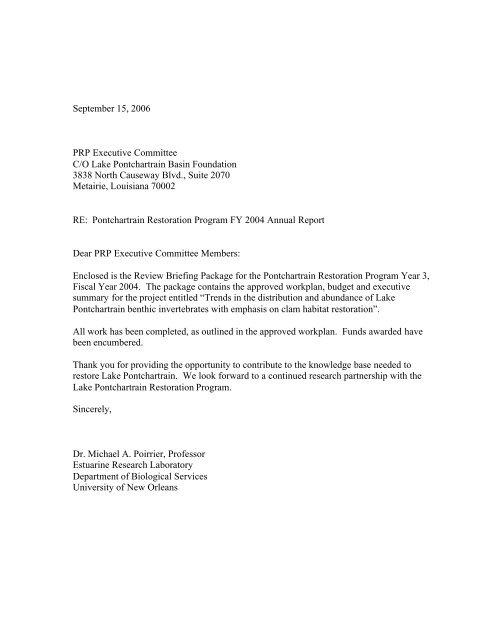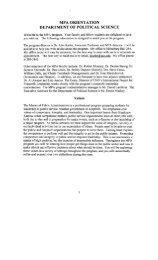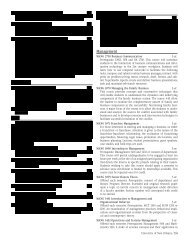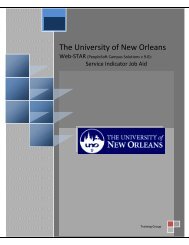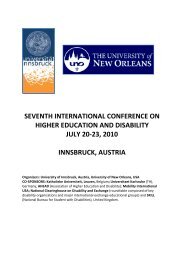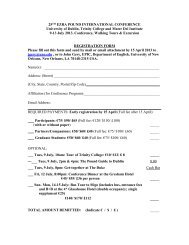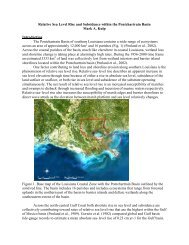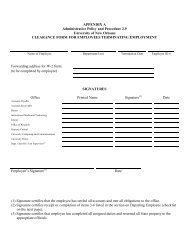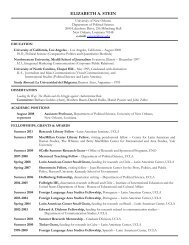Link to full text - Pontchartrain Basin Clearinghouse - University of ...
Link to full text - Pontchartrain Basin Clearinghouse - University of ...
Link to full text - Pontchartrain Basin Clearinghouse - University of ...
- No tags were found...
Create successful ePaper yourself
Turn your PDF publications into a flip-book with our unique Google optimized e-Paper software.
September 15, 2006<br />
PRP Executive Committee<br />
C/O Lake <strong>Pontchartrain</strong> <strong>Basin</strong> Foundation<br />
3838 North Causeway Blvd., Suite 2070<br />
Metairie, Louisiana 70002<br />
RE: <strong>Pontchartrain</strong> Res<strong>to</strong>ration Program FY 2004 Annual Report<br />
Dear PRP Executive Committee Members:<br />
Enclosed is the Review Briefing Package for the <strong>Pontchartrain</strong> Res<strong>to</strong>ration Program Year 3,<br />
Fiscal Year 2004. The package contains the approved workplan, budget and executive<br />
summary for the project entitled “Trends in the distribution and abundance <strong>of</strong> Lake<br />
<strong>Pontchartrain</strong> benthic invertebrates with emphasis on clam habitat res<strong>to</strong>ration”.<br />
All work has been completed, as outlined in the approved workplan. Funds awarded have<br />
been encumbered.<br />
Thank you for providing the opportunity <strong>to</strong> contribute <strong>to</strong> the knowledge base needed <strong>to</strong><br />
res<strong>to</strong>re Lake <strong>Pontchartrain</strong>. We look forward <strong>to</strong> a continued research partnership with the<br />
Lake <strong>Pontchartrain</strong> Res<strong>to</strong>ration Program.<br />
Sincerely,<br />
Dr. Michael A. Poirrier, Pr<strong>of</strong>essor<br />
Estuarine Research Labora<strong>to</strong>ry<br />
Department <strong>of</strong> Biological Services<br />
<strong>University</strong> <strong>of</strong> New Orleans
PONTCHARTRAIN RESTORATION PROGRAM (PRP)<br />
FY 2004 ANNUAL REPORT<br />
APPROVED WORK PLAN, BUDGET & EXECUTIVE<br />
SUMMARY<br />
Title<br />
Trends in the distribution and abundance <strong>of</strong> Lake <strong>Pontchartrain</strong><br />
benthic invertebrates with emphasis on clam habitat res<strong>to</strong>ration<br />
From<br />
Michael A. Poirrier, Pr<strong>of</strong>essor<br />
Department <strong>of</strong> Biological Sciences<br />
<strong>University</strong> <strong>of</strong> New Orleans<br />
Lakefront<br />
New Orleans, LA 70148<br />
To<br />
PRP Executive Committee<br />
C/O Lake <strong>Pontchartrain</strong> <strong>Basin</strong> Foundation<br />
3838 North Causeway Blvd., Suite 2070<br />
Metairie, Louisiana 70002<br />
Funding Agency: NOAA<br />
Start Date: September 1, 2004<br />
End Date: August 31, 2005<br />
Report Date: September 15, 2006<br />
Total Funding: $90,000.00
PONTCHARTRAIN RESTORATION PROGRAM (PRP)<br />
FY 2004 ANNUAL REPORT<br />
APPROVED WORK PLAN
SCOPE OF SERVICES<br />
Background: Past studies <strong>of</strong> Lake <strong>Pontchartrain</strong> indicated a stressed benthic invertebrate<br />
community. Causes <strong>of</strong> stress were believed <strong>to</strong> be shell dredging and <strong>to</strong>xic compounds in the<br />
sediment. Recent studies indicate that recovery from shell dredging has occurred and that<br />
sediment contamination is not a major problem, but that saltwater intrusion and episodic<br />
hypoxia are serious problems. Unnaturally high salinity bot<strong>to</strong>m water has entered Lake<br />
<strong>Pontchartrain</strong> since the Mississippi River Gulf Outlet was completed in 1963. This saline<br />
water produces stratification and bot<strong>to</strong>m hypoxia. Low benthic invertebrate species diversity<br />
and the absence <strong>of</strong> large (> 20 mm) Rangia cuneata clams from a 100 mi 2 north <strong>of</strong> the IHNC<br />
documented in previous studies demonstrated a major impact. During the drought associated<br />
with the La Niña climate pattern from 1998 <strong>to</strong> 2002, benthic invertebrate species diversity<br />
and Rangia clam density decreased lake-wide from 374 <strong>to</strong> 4 clams/m 2 . This decrease in<br />
species diversity and in Rangia abundance throughout the lake may have been due <strong>to</strong><br />
episodes <strong>of</strong> lake-wide low dissolved oxygen. Salinity has since returned <strong>to</strong> normal, but<br />
Rangia clams have not recovered. Additional studies are needed during 2004 and 2005 <strong>to</strong><br />
obtain information needed <strong>to</strong> determine causal fac<strong>to</strong>rs. These studies would provide<br />
information on the effects <strong>of</strong> salinity shifts on the overall benthic community; possible<br />
occurrence and effects <strong>of</strong> lake-wide hypoxia resulting from salinity stratification; the rate <strong>of</strong><br />
benthic invertebrate recovery, especially Rangia clams; and Rangia growth rates.<br />
Goals: The long-term goal is <strong>to</strong> provide the knowledge needed <strong>to</strong> res<strong>to</strong>re the benthic<br />
community. Cases <strong>of</strong> decline and recovery need <strong>to</strong> be determined and natural variation<br />
separated from human-induced changes. The working hypothesis is that saltwater intrusion is<br />
the primary cause <strong>of</strong> stress, but additional data on the extent and degree <strong>of</strong> stress and benefits<br />
<strong>of</strong> res<strong>to</strong>ration are needed. Information on the effects <strong>of</strong> Mississippi River diversions is also<br />
needed. The primary goal for 2004-2005 studies is <strong>to</strong> determine the cause <strong>of</strong> Rangia decline<br />
and the rate <strong>of</strong> recovery.<br />
Objectives: (1) Determine the status <strong>of</strong> the bot<strong>to</strong>m biota <strong>of</strong> Lake <strong>Pontchartrain</strong> by<br />
conducting lake-wide surveys <strong>of</strong> the distribution and abundance <strong>of</strong> benthic invertebrates<br />
during 2004 and 2005. (2) Relate 2004-2005 data <strong>to</strong> his<strong>to</strong>ric data <strong>to</strong> determine status and<br />
trends. This analysis will focus on the effects <strong>of</strong> hypoxia from salinity stratification, but will<br />
also include possible changes due <strong>to</strong> spillway openings/leakage, shell dredging, <strong>to</strong>xic<br />
chemicals, eutrophication, and shifts in overall ecosystem structure. (3) Determine changes<br />
in the population dynamics <strong>of</strong> Rangia clams due <strong>to</strong> drought driven salinity changes and<br />
recovery after a return <strong>to</strong> normal rainfall. (4) Based on benthic-invertebrate indica<strong>to</strong>r species,<br />
evaluate the current area affected by hypoxia from salinity stratification in 2004 and 2005<br />
(100 mi 2 in 1999).<br />
Project Methodology: Materials and methods employed in past UNO studies <strong>of</strong> Lake<br />
<strong>Pontchartrain</strong> benthic invertebrates will be used in this study. Sites on established transects<br />
will be sampled (three replicates) with a petite Ponar grab, sieved through a 0.6 mm screen<br />
bucket, preserved in formalin with rose Bengal stain in the field, and sorted and identified in<br />
the labora<strong>to</strong>ry. Statistical analyses <strong>of</strong> data will include ANOVA and analyses in PRIMER<br />
(Plymouth Routines in Multivariate Ecological Research). All comparisons <strong>of</strong> data sets,<br />
1
conclusions from data sets and hypothetical projections will be presented with appropriate<br />
statistical measures, based on significance within the 95 % confidence interval.<br />
Timeline and Miles<strong>to</strong>nes: During the 1 st Quarter (September through November), fall<br />
transects will be conducted, samples processed, and data entered. A paper will be presented<br />
at the ERCLA meeting. During the 2 nd Quarter (December through February), data entry will<br />
be completed, statistical analyses performed, results compared <strong>to</strong> his<strong>to</strong>ric data <strong>to</strong> determine<br />
trends and causal relationships, and a semiannual report will be prepared and submitted.<br />
Spring transects will be completed, samples processed, and data entered during the 3 rd<br />
Quarter (March through May). During the 4 th Quarter (June through August), data entry will<br />
be completed and statistical analyses performed. A final report will be submitted by the end<br />
<strong>of</strong> September 2005. Manuscripts for journal publication will be prepared and submitted.<br />
Deliverables: Deliverables will include semiannual reports. Results will be made available in<br />
the form <strong>of</strong> student theses, journal publications, meeting abstracts, poster and oral<br />
presentations at regional and national conferences, and other reports.<br />
Quality Control Measures: A QAPP is not required, but has been prepared for related work<br />
funded through EPA. All work will employ appropriate instrument maintenance and<br />
calibration, secure data management, trained personnel, control and replicate sampling and<br />
statistical testing. Results will be submitted for publication in peer-reviewed academic<br />
journals.<br />
Techniques for assessing success. All comparisons <strong>of</strong> data sets, conclusions from data sets<br />
and hypothetical projections will be presented with appropriate statistical measures, based on<br />
significance within the 95 % confidence interval.<br />
Personnel Qualifications: The <strong>University</strong> <strong>of</strong> New Orleans is an established research<br />
university with labora<strong>to</strong>ries, equipment, BS, MS, and PhD programs, and other resources for<br />
conducting the proposed work. The P.I., Dr. Michael Poirrier, has thirty-three years <strong>of</strong><br />
experience as a research faculty member at UNO. He has authored, or coauthored 13 book<br />
chapters, 47 journal articles, 28 technical reports, and 114 presentations at pr<strong>of</strong>essional<br />
meetings, and served as major pr<strong>of</strong>essor for 28 graduate students. He has conducted research<br />
on Lake <strong>Pontchartrain</strong> since 1969 and many <strong>of</strong> his publications pertain <strong>to</strong> Lake <strong>Pontchartrain</strong><br />
biota and water quality. He has managed large externally funded research projects throughout<br />
his career. Dr. Poirrier participated in efforts <strong>to</strong> establish the Lake <strong>Pontchartrain</strong> <strong>Basin</strong><br />
Foundation and served on committees <strong>to</strong> draft the Lake <strong>Pontchartrain</strong> <strong>Basin</strong> Comprehensive<br />
Management Plan. Elizabeth Spalding, a <strong>full</strong> time research associate, has a Masters degree in<br />
Biological Sciences and over seven years <strong>of</strong> experience in environmental science. Carol<br />
Franze, a research associate, will work half time on this project. She has an MA degree in<br />
Geography with a specialty in environmental analysis and has conducted research in the<br />
<strong>Pontchartrain</strong> <strong>Basin</strong> for over ten years.<br />
2
PONTCHARTRAIN RESTORATION PROGRAM (PRP)<br />
FY 2003 ANNUAL REPORT<br />
APPROVED BUDGET
APPROVED BUDGET<br />
Category Amount Requested Match & Source<br />
Personnel $ 71,550.00 $ 9,748.00 / UNO<br />
Travel $ 2,000.00<br />
Supplies $ 2,000.00<br />
Indirect Cost (14%) $ 10,577.00 $25,248.00 / UNO<br />
Equipment $ 3,873.00<br />
Total $ 90,000.00 $34,996.00 / UNO<br />
Justification:<br />
Personnel: (1) Michael A. Poirrier, Principle Investiga<strong>to</strong>r - 1.5 months summer salary.<br />
Funds are needed because his university appointment does not provide<br />
summer support during this period <strong>of</strong> intense research effort.<br />
(2) Elizabeth Spalding, Research Associate – 6 months support.<br />
(3) Carol Franze, Research Associate – 9 months support.<br />
Standard <strong>University</strong> fringe benefits at 21% <strong>of</strong> <strong>full</strong>-time salaries for Poirrier, Spalding and<br />
Franze.<br />
(4) Undergraduate Student Workers at $5 - $8 / hour.<br />
Travel: Funds are requested <strong>to</strong> support local field travel and participation at a national<br />
meeting. Local field travel will include vehicle mileage ($.32/mi) and boat gas and<br />
maintenance.<br />
Supplies: Funds are requested <strong>to</strong> purchase preservatives, reagents, glassware, microscope<br />
slides, waters sample bottles, computer s<strong>of</strong>tware and other item needed <strong>to</strong> conduct research.<br />
Overhead: 14% <strong>of</strong> costs excluding equipment, as established by NOAA and UNO.<br />
Equipment: Funds are requested <strong>to</strong> replace older field equipment which may cease <strong>to</strong><br />
function.<br />
Matching funds represent Principle Investiga<strong>to</strong>r release-time for research, and the difference<br />
between UNO standard Indirect/overhead Rate (42%) and the established rate by NOAA (14<br />
BUDGET STATUS<br />
All funds awarded have been encumbered.<br />
1
PONTCHARTRAIN RESTORATION PROGRAM (PRP)<br />
FY 2003 ANNUAL REPORT<br />
EXECUTIVE SUMMARY
RELEVANCE TO THE COMPREHENSIVE MANAGEMENT PLAN<br />
The project supports moni<strong>to</strong>ring, res<strong>to</strong>ration and educational objectives <strong>of</strong> the Lake <strong>Pontchartrain</strong><br />
<strong>Basin</strong> Comprehensive Management Plan. Benthic invertebrates comprise a critically impaired<br />
bot<strong>to</strong>m habitat that is essential <strong>to</strong> the survival <strong>of</strong> fish, crabs, shrimp, and waterfowl. Rangia<br />
cuneata can filter a volume <strong>of</strong> water equivalent <strong>to</strong> the volume <strong>of</strong> Lake <strong>Pontchartrain</strong> every 3-5<br />
days, and through this feeding activity, reduce the impact <strong>of</strong> sewage, agriculture and s<strong>to</strong>rm water<br />
run<strong>of</strong>f and Mississippi River diversions by processing phy<strong>to</strong>plank<strong>to</strong>n, sediment, and bacteria.<br />
Clams add almost a million <strong>to</strong>n <strong>of</strong> shells each year <strong>to</strong> the sediment. Dramatic improvements in<br />
the environmental quality <strong>of</strong> Lake <strong>Pontchartrain</strong> should occur if the benthic community is<br />
res<strong>to</strong>red. In addition, benthic invertebrates serve as indica<strong>to</strong>rs <strong>of</strong> lake quality, especially the<br />
deleterious effects <strong>of</strong> saltwater intrusion and the effects <strong>of</strong> res<strong>to</strong>ration efforts. Finally, this project<br />
educates university students at all levels, and results are presented <strong>to</strong> the public through diverse<br />
media.<br />
INTRODUCTION<br />
Past studies <strong>of</strong> Lake <strong>Pontchartrain</strong> indicated a stressed benthic invertebrate community. Causes<br />
<strong>of</strong> stress were believed <strong>to</strong> be shell dredging and <strong>to</strong>xic compounds in the sediment. Recent studies<br />
indicate that recovery from shell dredging has occurred and that sediment contamination is not a<br />
major problem, but that saltwater intrusion and episodic hypoxia are serious problems.<br />
Unnaturally high salinity bot<strong>to</strong>m water has entered Lake <strong>Pontchartrain</strong> since the Mississippi<br />
River Gulf Outlet (MRGO) was completed in 1963. This saline water produces stratification and<br />
bot<strong>to</strong>m hypoxia. Low benthic invertebrate species diversity and the absence <strong>of</strong> large (> 21 mm)<br />
Rangia cuneata clams from a 100 mi 2 north <strong>of</strong> the IHNC documented in previous studies<br />
demonstrated a major impact. Hypoxic episodes are known <strong>to</strong> extend beyond this zone <strong>of</strong><br />
obvious impact and the area affected may be much larger.<br />
During the La Niña climate pattern drought from 1998 <strong>to</strong> 2002, benthic invertebrate species<br />
diversity increased with salinity and Rangia clam density decreased lake-wide from 374 <strong>to</strong> 4<br />
clams/m 2 . The decrease in Rangia abundance may have been due <strong>to</strong> episodes <strong>of</strong> lake-wide low<br />
dissolved oxygen. Salinity has since returned <strong>to</strong> normal, but Rangia clams have not recovered.<br />
Additional studies have been conducted during 2004 and 2005 <strong>to</strong> obtain information needed <strong>to</strong><br />
determine causal fac<strong>to</strong>rs. These studies provide information on the effects <strong>of</strong> salinity shifts on the<br />
overall benthic community; possible occurrence and effects <strong>of</strong> lake-wide hypoxia resulting from<br />
salinity stratification; and the rate <strong>of</strong> benthic invertebrate recovery, especially Rangia clams.<br />
GOALS<br />
The long-term goal is <strong>to</strong> provide the knowledge needed <strong>to</strong> res<strong>to</strong>re the benthic community. Causes<br />
<strong>of</strong> decline and recovery need <strong>to</strong> be determined and natural variation separated from humaninduced<br />
changes. The working hypothesis is that saltwater intrusion is the primary cause <strong>of</strong><br />
stress, but additional data on the extent and degree <strong>of</strong> stress and benefits <strong>of</strong> res<strong>to</strong>ration are<br />
needed. Information on the effects <strong>of</strong> Mississippi River diversions is also needed. The primary<br />
goal for 2004-2005 studies is <strong>to</strong> determine the cause <strong>of</strong> Rangia cuneata decline and the rate <strong>of</strong><br />
recovery.<br />
1
WORK COMPLETED<br />
A lake-wide survey <strong>of</strong> benthic invertebrates and water quality parameters, such as salinity and<br />
dissolved oxygen, was conducted during the fall <strong>of</strong> 2004 and spring <strong>of</strong> 2005. Samples were<br />
processed and data analyzed. The condition <strong>of</strong> the benthic community in 2004-2005 was<br />
evaluated and results compared <strong>to</strong> our long-term data set (1996–2004). Trends within the longterm<br />
data set were analyzed using ANOVA, Primer, and ArcGis kriging analyses. Changes in the<br />
populations <strong>of</strong> the large bivalves were determined and related <strong>to</strong> changes in water quality. The<br />
area affected by detrimental low dissolved oxygen concentrations from salinity stratification was<br />
evaluated based on species diversity values, community composition, and abundance <strong>of</strong> large<br />
bivalves.<br />
RESULTS<br />
Water quality parameters, species diversity, number <strong>of</strong> Rangia cuneata, and biomass <strong>of</strong> clams<br />
show a slow recovery after the drought. Salinity data from April 2004 <strong>to</strong> November 2005<br />
indicate a return <strong>to</strong> typical spatial and seasonal changes. Salinity increased from west <strong>to</strong> east and<br />
was higher in fall (ave. = 5.7 ppt) than spring (ave. = 4.3 ppt). Although slightly higher than the<br />
Lake average <strong>of</strong> 4 ppt, these values differ from the high values (> 9 ppt) during the 1998-2001<br />
drought from an El Niño climate shift. The return <strong>to</strong> a typical regime has resulted in a shift <strong>to</strong> a<br />
community dominated by species adapted <strong>to</strong> lower salinity.<br />
Species diversity values from 1996-2005 surveys for the west <strong>to</strong> east transect are presented in<br />
Figure 1. Previous results showed increasing species diversity with increasing salinity due <strong>to</strong> the<br />
drought. A slow return <strong>to</strong> typical species diversity values that increase from west <strong>to</strong> east with the<br />
salinity gradient is apparent and expected. Species diversity values ranged from an average <strong>of</strong><br />
1.4 in the western portion <strong>of</strong> the lake <strong>to</strong> 2.3 in the eastern portion.<br />
Associated with the drought was a lake-wide die-<strong>of</strong>f <strong>of</strong> Rangia clams that occurred between July<br />
2000 and April 2001. Numerous small clams (
MAJOR FINDINGS<br />
· Water quality parameters, species diversity, number <strong>of</strong> Rangia cuneata, and biomass <strong>of</strong><br />
clams show a slow recovery after from the 2001 lake-wide die-<strong>of</strong>f caused by stress from<br />
low dissolved oxygen.<br />
· Although number <strong>of</strong> clams has increased since the drought, the population in composed<br />
<strong>of</strong> young, small clams, i.e. low biomass numbers.<br />
· The primary source <strong>of</strong> stress that causes low species diversity and kills Rangia clams is<br />
low dissolved oxygen from saltwater intrusion from the Mississippi River Gulf Outlet via<br />
the Inner Harbor Navigation Canal as evidenced by the persistent, large “dead zone”.<br />
Closure <strong>of</strong> the MRGO should alleviate this stress.<br />
SIGNIFICANCE<br />
This study documents the detrimental effects <strong>of</strong> saltwater intrusion from the Mississippi River<br />
Gulf Outlet on benthic invertebrates in Lake <strong>Pontchartrain</strong>. It also provides information on the<br />
effects <strong>of</strong> natural climate shifts on benthic community structure, resiliency <strong>of</strong> the Lake<br />
<strong>Pontchartrain</strong> system, and recovery rates after major disturbance. In addition, this study provides<br />
baseline data <strong>to</strong> evaluate the effects <strong>of</strong> Hurricane Katrina.<br />
DELIVERABLES<br />
· Poirrier, M.A. and E.A. Spalding. 2005. Special Report: The importance <strong>of</strong> Rangia cuneata<br />
clam res<strong>to</strong>ration <strong>to</strong> the holistic rehabilitation <strong>of</strong> the Lake <strong>Pontchartrain</strong> estuary. Submitted <strong>to</strong><br />
the Lake <strong>Pontchartrain</strong> <strong>Basin</strong> Foundation CMP Committee. 11 pgs.<br />
· Poirrier, M.A. The importance <strong>of</strong> Rangia clams and submerged macrophytes <strong>to</strong> the holistic<br />
res<strong>to</strong>ration <strong>of</strong> Lake <strong>Pontchartrain</strong>. Environmental State <strong>of</strong> the State Conference, New<br />
Orleans. Oc<strong>to</strong>ber 2004<br />
· Poirrier, M.A. and E.A. Spalding. The importance <strong>of</strong> Rangia cuneata clam res<strong>to</strong>ration <strong>to</strong> the<br />
holistic rehabilitation <strong>of</strong> Lake <strong>Pontchartrain</strong>. Seventh International Shellfish Res<strong>to</strong>ration<br />
Conference, Charles<strong>to</strong>wn, S.C. November 2004.<br />
· Poirrier, M.A. and E.A. Spalding. Environmental services provided by Rangia clams and the<br />
benefits derived from the res<strong>to</strong>ration <strong>of</strong> 250 km 2 <strong>of</strong> clam habitat in Lake <strong>Pontchartrain</strong>.<br />
Benthic Ecology Meeting. March 2005, Williamsburg Virginia.<br />
· Brammer, Amanda J., Ryan S. Poirrier and Michael A. Poirrier. Changes in the density <strong>of</strong><br />
Ischadium recurvum cased by a drought from an El Nino southern oscillation shift. Gulf<br />
Estuarine Research Society Meeting. March 2005. Pensacola, Florida.<br />
· Poirrier, Michael A. and Elizabeth Anne Spalding. The importance <strong>of</strong> Rangia clam<br />
res<strong>to</strong>ration <strong>to</strong> the holistic rehabilitation <strong>of</strong> the Lake <strong>Pontchartrain</strong> estuary. Coastal Res<strong>to</strong>ration<br />
and Enhancement through Science and Technology Meeting. April 2005. Lafayette,<br />
Louisiana.<br />
3
4.0<br />
3.5<br />
3.0<br />
Bonnet Carré<br />
Spillway Opening<br />
El Niño Drought<br />
12<br />
10<br />
Species Diversity<br />
2.5<br />
2.0<br />
1.5<br />
1.0<br />
8<br />
6<br />
4<br />
0.5<br />
0.0<br />
Nov-96<br />
Apr-97<br />
Oct-97<br />
May-98<br />
Nov-98<br />
Apr-99<br />
Oct-99<br />
May-00<br />
Jul-00<br />
Apr-01<br />
Aug-02<br />
Nov-03<br />
Apr-04<br />
Nov-04<br />
Apr-05<br />
Salinity (ppt)<br />
EW1<br />
EW2<br />
EW3<br />
EW4<br />
EW5<br />
Bot<strong>to</strong>m<br />
Salinity<br />
2<br />
0<br />
Date Sampled<br />
Figure 1. Species diversity values and average bot<strong>to</strong>m salinity level <strong>of</strong> five west <strong>to</strong> east stations<br />
across Lake <strong>Pontchartrain</strong> from 1996 – 2005 surveys.<br />
Rangia cuneata per m 2<br />
3000<br />
2500<br />
2000<br />
1500<br />
1000<br />
500<br />
0<br />
41-45 mm<br />
36-40 mm<br />
31-35 mm<br />
26-30 mm<br />
21-25 mm<br />
16-20 mm<br />
11-15 mm<br />
6-10 mm<br />
< 5 mm<br />
EW1 EW2 EW3 EW4 EW5 EW1 EW2 EW3 EW4 EW5<br />
November 2004 April 2005<br />
Figure 2. Density by size class <strong>of</strong> Rangia cuneata at five west <strong>to</strong> east stations across Lake<br />
<strong>Pontchartrain</strong> in November 2004 and April 2005.<br />
4


